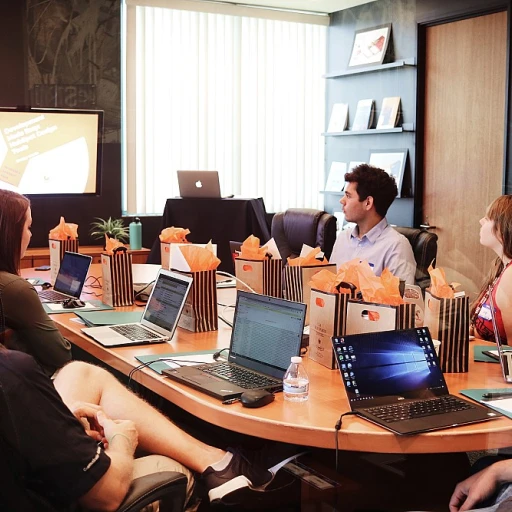-teaser.webp)
Understanding the Role of a CTO
The Critical Influence of a CTO
Understanding the nuanced role a CTO plays within a tech company is fundamental to effective succession planning. The Chief Technology Officer, or CTO, is not just a part of the leadership team but a pivotal figure driving the organization’s technical strategy and innovation. This strategic position involves not only managing the company's technology stack but also influencing critical decision making to align with the business goals. CTOs wield immense influence over the technical development and the business's future directions. They are essentially visionaries, steering the tech team to position the company advantageously in the competitive tech landscape. This complex role requires a deep understanding of the industry, robust leadership, and the ability to foresee the company’s tech needs long-term. One essential duty of a CTO is ensuring that the team is equipped with the right talent and technical knowledge to maintain continuity and foster innovation. Their leadership development initiatives are vital in creating a pool of high potential individuals who could be potential successors to the CTO role. Having a succession plan in place allows a company to mitigate risks associated with losing key personnel unexpectedly. The absence of a CTO can disrupt the tech side of the organization's operations, making it crucial to identify potential successors who can smoothly transition into leadership roles and carry on the outgoing CTO's vision. For more insights into understanding key leadership roles within organizations, you might explore the detailed specifications on the role of a personnel manager as outlined here.Identifying Potential Successors
Recognizing High-Potential Leaders
Identifying potential successors within your organization is a crucial step in building a robust succession plan. To pinpoint the right candidates, consider individuals who not only demonstrate technical proficiency in their roles but also exhibit leadership capabilities. This dual set of skills ensures that the individual will seamlessly step into the CTO role, aligning with business objectives and driving the company forward. Selecting the right talent for succession planning goes beyond simply looking at current performance. It's essential to evaluate candidates based on long-term potential and their ability to adapt to strategic shifts. Individuals who are keen on leadership development and have shown adaptability in challenging situations tend to make strong candidates for critical roles like that of a CTO. The planning process should incorporate a mix of quantitative and qualitative assessments to understand a candidate's potential thoroughly. Feedback from multiple levels of the organization can also provide valuable insights, as different team members may shed light on the potential successor's ability to adapt to leadership roles. Utilizing these strategies not only helps in recognizing the right talent but also reinforces the continuity of technical and strategic leadership within your organization. For more insights on understanding roles within workforce planning, you may explore key specifications and responsibilities.Developing a Succession Plan
Crafting a Comprehensive Strategy for CTO Succession
Planning the succession of a Chief Technology Officer (CTO) is a vital component for ensuring the long-term success and continuity of a tech firm. A well-thought-out succession strategy not only addresses the company’s immediate needs but also looks forward to future requirements, adjusting to industry advancements. A structured approach to succession planning involves various critical steps:- Establishing Key Criteria: Define the essential roles and responsibilities the incoming CTO will take on. Different organizations might have varied needs, depending on their business goals and technical direction. It is essential to align the potential CTO's skills with the company's long-term objectives.
- Formalizing Leadership Development: Once potential successors are identified, focus on leadership development. Tailored leadership roles within tech teams can prepare high-potential candidates, enhancing their decision-making capabilities. This development helps in nurturing a ready-to-deploy talent group, ensuring leadership continuity in the organization.
- Creating a Knowledge Transfer Protocol: Effective succession requires a structured knowledge transfer process. The outgoing CTO plays a key role in imparting technical and organizational knowledge to the successor. A smooth transition is possible when this knowledge exchange is well-documented based on best practices.
- Simulating Real-World Scenarios: Before the final decision, simulate different leadership scenarios to test the potential CTO’s response to real-world challenges. This helps in understanding their practical capabilities and readiness for the CTO role.
- Involving Cross-Department Audiences: Engage stakeholders from other departments to assess the leadership potential of successors. Cross-functional feedback is invaluable as it provides a holistic view of how potential successors interact across the business landscape.
Mitigating Risks in Succession Planning
Anticipating Challenges and Crafting Solutions
When structuring a comprehensive succession plan for the CTO role, it's essential to proactively consider potential risks that could arise throughout the process. Effective succession planning does not occur in a vacuum, especially in the ever-evolving tech landscape, where company continuity heavily depends on the seamless transition of leadership roles. Being prepared to confront and mitigate challenges head-on is crucial to long-term success.
One of the primary challenges is ensuring the continuity of technical expertise. The incoming CTO must be adequately prepared to fill critical roles and assume leadership responsibilities effectively. This requires a thorough knowledge transfer from the outgoing CTO. The outgoing CTO’s leadership development insights can prove invaluable in this transition phase to secure business continuity.
Another vital aspect to consider is the impact of succession on the organization's team dynamics. Changes in leadership may affect team morale and productivity. To mitigate this, involve key team members in the succession planning process to foster a sense of inclusion and collaboration. Highlighting potential successors within the company can help maintain morale by showing the organization's commitment to investing in its talent and valuing high-potential individuals.
The planning process must also account for the technical acumen of potential successors. It is crucial to evaluate their capability to drive the company’s tech strategies and innovation forward. Understanding their decision-making abilities and how they plan to lead the organization into the future is essential for mitigating risks related to ineffective leadership.
Developing contingency plans is another best practice to ensure a smooth transition. This involves identifying external talent who can step in if internal candidates are not ready or equipped to assume the CTO role yet. By having a solid external pool of candidates, the organization can reduce potential disruptions and maintain a competitive edge.
Leveraging External Talent
Unlocking New Avenues for Talent Acquisition
Exploring external talent sources is a vital step in succession planning for the CTO role. While focusing internally on leadership development and identifying high-potential team members is essential, bringing in external talent can introduce fresh perspectives, enhance continuity, and complement the existing company culture. Firstly, external hires can fill critical roles swiftly, especially if the organization lacks an immediate internal candidate ready for leadership. By integrating outside expertise, a business might gain competitive insights and enrich its technical team more dynamically. Engaging external talent effectively involves a clear understanding of the incoming CTO's responsibilities and expectations. When engaging an outside expert, aligning them with the organization's long-term goals and business strategies is fundamental. This ensures a smooth transition and knowledge transfer, aiding the continuity of the planning process. There are several steps businesses can take to optimize the integration of external talent:- Evaluate the Market: Conduct thorough market research to understand the landscape of potential successors outside the organization. This helps in identifying candidates with key technical and leadership skills.
- Leverage Networks: Utilize professional networks and industry connections to identify and attract competent candidates who can fulfill the role of CTO effectively.
- Professional Recruitment Firms: Consider engaging with recruitment firms that specialize in leadership roles within tech firms. These firms often have a pool of pre-vetted candidates suitable for long-term succession needs.
Evaluating the Succession Process
Ensuring Success through Constant Evaluation
Evaluating the succession process is a vital step in ensuring the long-term success and stability of any tech organization. With a focus on maintaining business continuity and fostering leadership development, this evaluation phase serves as a reflection point to assess whether the implemented CTO succession planning strategies have achieved their intended outcomes. To create a robust evaluation framework, consider the following key components:- Review of the Succession Implementation: Examine the steps taken in identifying potential successors and the development of the succession plan. This evaluation should focus on the planning process and how effectively it addressed the critical roles, particularly the CTO role.
- Assessment of Leadership Transition: Analyze how the incoming CTO manages the leadership roles they inherit. This includes determining whether there is a smooth transition and knowledge transfer from the outgoing CTO to the new leader, ensuring that the technical leadership remains intact.
- Feedback from Key Stakeholders: Engage with members of the leadership team, business managers, and even the potential successors involved in the process. Gathering feedback helps assess the effectiveness of the plan and areas for improvement.
- Monitoring Organizational Impact: Consider the company's performance metrics and employee satisfaction to gauge if the succession has met the organizational goals. An effective succession planning strategy should support the company's continuity and development.
- Continuous Development and Adaptation: Examine the ongoing talent management and development opportunities offered to high potential leaders within the organization. Updating succession plans regularly to align with changing business needs is crucial.














